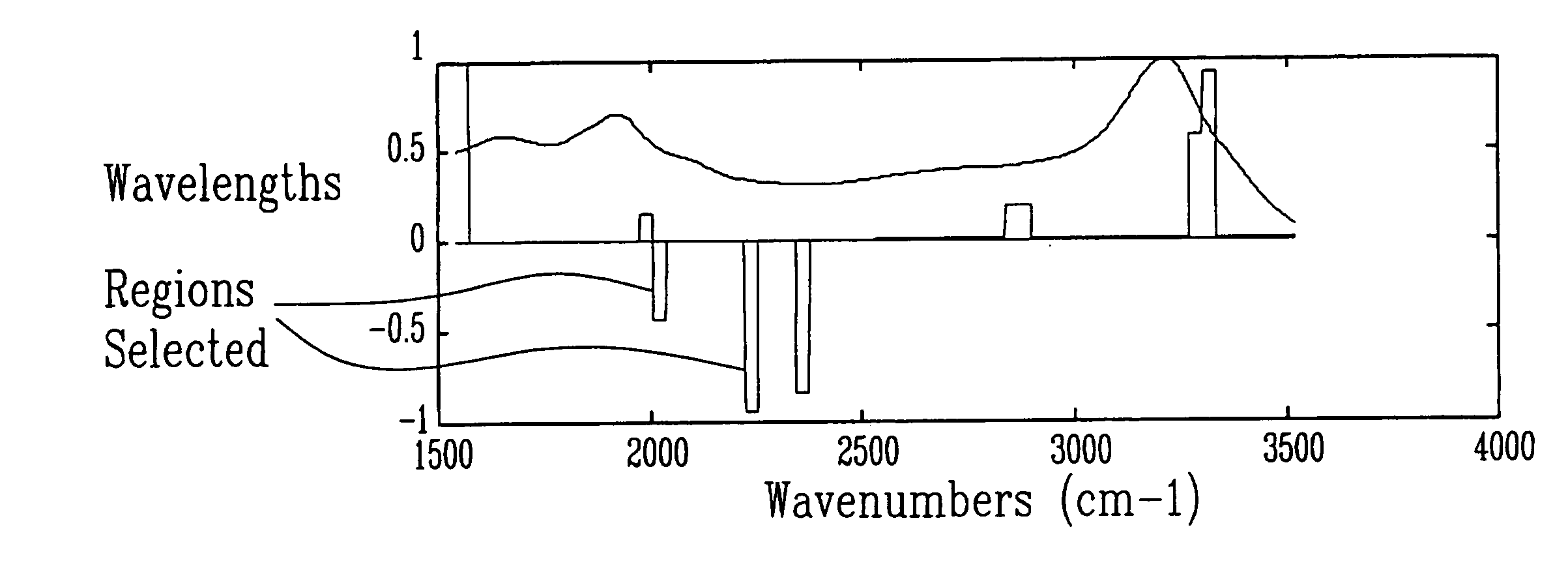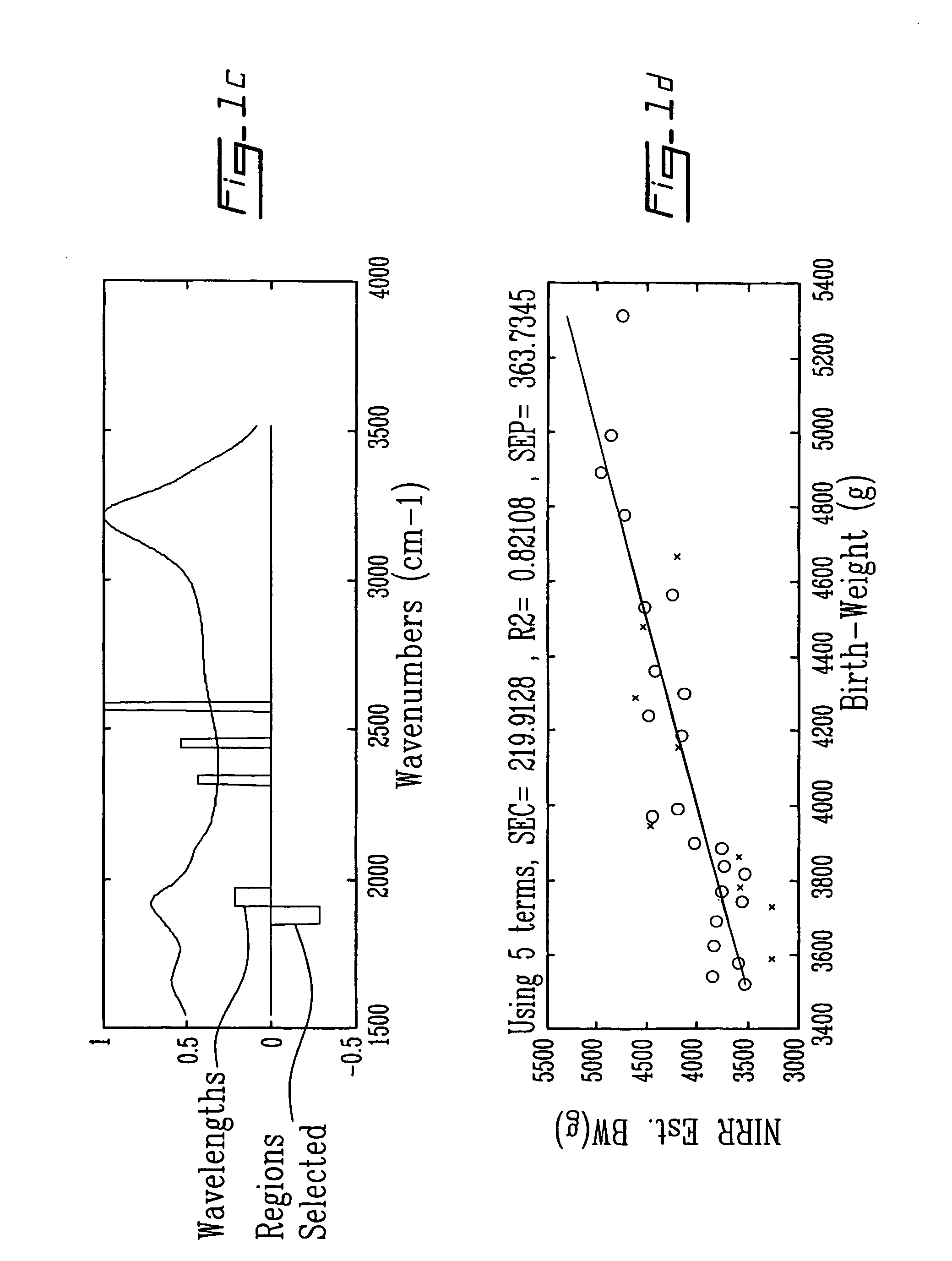Method and apparatus for analyzing amniotic fluid
- Summary
- Abstract
- Description
- Claims
- Application Information
AI Technical Summary
Benefits of technology
Problems solved by technology
Method used
Image
Examples
first embodiment
al Analysis of in Vitro Amniotic Fluid and Correlation with Birthweight in Humans
[0035] One embodiment of the invention focuses on the use of Raman spectral analyses to identify a panel of 8-12 biochemical markers in amniotic fluid that are predictive of infant birth weight. Advantages of our approach are (1) that it requires a single sample of a small volume of amniotic fluid (EL) to measure all important biochemical components simultaneously and thus importantly preserves their chemical properties within the fluid matrix of amniotic fluid, which in and of itself is important barometer of fetal health as either too little (oligiohydramniois) or too much (polyhydramniois) is a fetal health risk. This overcomes limitations of other chemical techniques that require separate analyses of individual components, which not only are susceptible to concentration differences if volume is perturbed, but to lack of techniques to measure components in this new compartment for which assays in sma...
second and third embodiments
cal Spectrometer
[0057] In the second embodiment, endo-vaginal spectral measurements are taken at the time of routine ultrasound which ranges from 2-5 times during the course of pregnancy. Early measurements present the opportunity for therapeutic or nutritional intervention. However, sensitivity of early gestational measurements may be reduced by the thickness of cervical tissue (˜4 mm). In contrast, endo-vaginal measurements made later in pregnancy provide less interference from cervical tissue (<1 mm), as it thins throughout pregnancy, but there is less opportunity for medical intervention. It will be appreciated that ultrasound images of the amniotic sac may be used to help arranging the probe to direct or confirm that the probe will measure the amniotic fluid without interference of the fetus. If desired, the optical spectrometer may be incorporated into an ultrasound endo-vaginal probe.
[0058] The spectral regions which are critical in birth weight prediction for in situ measur...
fourth and fifth embodiments
abetes Mellitus (GDM) Using Repeated Non-Invasive Amniotic Fluid Analysis
[0069] Our study goals were fourfold: 1) to describe the prevalence of GDM in a population of older women undergoing routine amniocentesis for genetic testing and at higher risk because of age; 2) to show if elevations in amniotic fluid (AF) glucose, insulin or insulin-like-growth-factor binding protein (IGF BP) 1 pre-existed at the time of routine amniocentesis (range 12-22 wks) in those women diagnosed at 24-28 wks with GDM; 3) to establish, using multiple regressions, if an association with these amniotic fluid indices and later GDM diagnosis existed; and 4) to demonstrate, using probability maps, specific amniotic fluid concentrations for glucose, insulin and IGF BP 1 that were predictive of increased risk for GDM.
[0070] Design, Recruitment and Consent: From 1998-2002, pregnant women undergoing routine amniocentesis at St Mary's Hospital Center in Montreal Canada were approached to participate in this pros...
PUM
 Login to View More
Login to View More Abstract
Description
Claims
Application Information
 Login to View More
Login to View More - R&D
- Intellectual Property
- Life Sciences
- Materials
- Tech Scout
- Unparalleled Data Quality
- Higher Quality Content
- 60% Fewer Hallucinations
Browse by: Latest US Patents, China's latest patents, Technical Efficacy Thesaurus, Application Domain, Technology Topic, Popular Technical Reports.
© 2025 PatSnap. All rights reserved.Legal|Privacy policy|Modern Slavery Act Transparency Statement|Sitemap|About US| Contact US: help@patsnap.com



